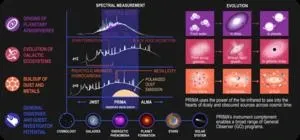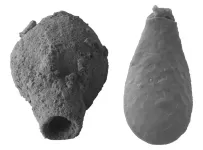October 4, 2024
UMass Amherst Astronomer Leads Science Team Helping to Develop Billion-Dollar NASA Satellite Mission Concept
Alexandra Pope, science lead for the PRIMA space telescope, is on team developing next-generation space probe that will explore evolution of the universe
AMHERST, Mass. – A University of Massachusetts astronomy professor is science lead on a $5 million proposal selected by NASA to develop new space satellite missions that bridge gaps in our understanding of the evolution of the universe.
Alexandra Pope of UMass Amherst is on one of two teams chosen by NASA to conduct 12-month mission concepts to observe X-ray and far-infrared wavelengths of light from space. Pope’s team is developing PRIMA, the Probe far-Infrared Mission for Astrophysics. After detailed evaluation of each $5 million study, NASA expects to select one concept in 2026 to proceed with the $1 billion construction, with launch projected to happen in 2032.
“One of the things that is so exciting about PRIMA is that it is going to fill in the gap between the James Webb Space Telescope (JWST), and the Alma Large Millimeter Array, or ALMA, in Chile,” says Pope. Both telescopes see the bookends of the infrared spectrum. JWST can see wavelengths up to 28 microns, and ALMA can see above 300 microns — but there are currently no telescopes that can observe from 28 to 300 microns, which is where PRIMA comes in. “It’s an enormous gap” says Pope, “and filling it will not only allow us to address three key science goals, it will open vast areas of research to the wider astronomy community.”
The PRIMA team, whose principal investigator, Jason Glenn, hails from the Goddard Space Flight Center, proposes to investigate three core science questions.
First, the team wants to understand how planets form their atmospheres, and, in particular, how water finds its way to a planet. IR spectroscopy will allow astronomers to trace cool water, a prerequisite for life as we know it, in planet-forming disks as they coalesce into planets.
The second theme will explore the co-evolution of supermassive black holes and galaxies.
Third, the team wants to understand how the universe built up the more complex elements of the periodic table beyond the initial two released by the Big Bang: helium and hydrogen. There are various ways to do this, but the one it will pursue is to use PRIMA’s IR sensors to examine cosmic dust in different environments and at different times across the universe. By measuring different samples’ properties, the team hopes to be able to understand how the elements evolved.
Of course, before PRIMA can do any of this, it has to make it through the final round of selection. Whichever mission concept is selected will receive $1 billion to develop what will become the first in a new class of NASA astrophysics missions within the agency’s longstanding Explorers Program. The new mission class, Probe Explorers, will fill a gap between flagship and smaller-scale missions in NASA’s exploration of the secrets of the universe.
As science lead, Pope’s job is to oversee the develop of the research questions and experiments that will drive which instruments are taken aboard the satellite and how they are designed. She is particularly excited about PRIMA’s potential to probe the link between supermassive black holes and galaxies.
“My group at UMass Amherst studies the co-evolution of galaxies and supermassive black holes,” says Pope. “I’ve spent my career working on this, and PRIMA is the ultimate tool that can help us understand the relationship between the two.”
Currently, astronomers think that every massive galaxy, like our own Milky Way, hosts a super-massive black hole at its center, and the size of the two seem to correlate. “This might seem obvious,” says Pope, “but the way that galaxies and black holes grow are very different.” How the two co-evolve remains an open question, which PRIMA is primed to help answer, because its IR instruments will be able to peer through the cosmic dust that cloaks both black holes and galaxies.
“NASA’s Explorers Program brings out some of the most creative ideas for missions that help us reveal the unknown about our universe. Establishing this new line of missions — the largest our astrophysics program has ever competed — has taken that creativity to new heights,” said Nicola Fox, associate administrator, Science Mission Directorate at NASA Headquarters in Washington. “Both of the selected concepts could enable ground-breaking science responsive to the top astrophysics priorities of the decade, develop key technologies for future flagship missions, and offer opportunities for the entire community to use the new observatory, for the benefit of all.”
The National Academies of Sciences, Engineering and Medicine’s 2020 Decadal Survey, Pathways to Discovery in Astronomy and Astrophysics for the 2020s, recommended NASA establish this new mission class, with the first mission observing either X-ray or far-infrared light wavelengths. Mission costs for the new Probe Explorers are capped at $1 billion each, not including the cost of the rocket, launch services, or any contributions.
The Explorers Program is the oldest continuous NASA program designed to provide frequent, low-cost access to space using principal investigator-led space science investigations relevant to the Science Mission Directorate’s astrophysics and heliophysics programs. Since the Explorer 1 launch in 1958, which discovered Earth’s radiation belts, the Explorers Program has launched more than 90 missions, including the Uhuru and Cosmic Background Explorer missions that garnered Nobel prizes for their investigators.
“It’s an honor to be the science lead for PRIMA and to bring the perspective and culture of public research universities to our collaboration with our NASA partners” says Pope.
A recorded interview with Alexandra Pope is available on Vimeo at: https://vimeo.com/1016161247/9db0221acb?share=copy
Contacts: Alexandra Pope, pope@astro.umass.edu
Daegan Miller, drmiller@umass.edu
END




